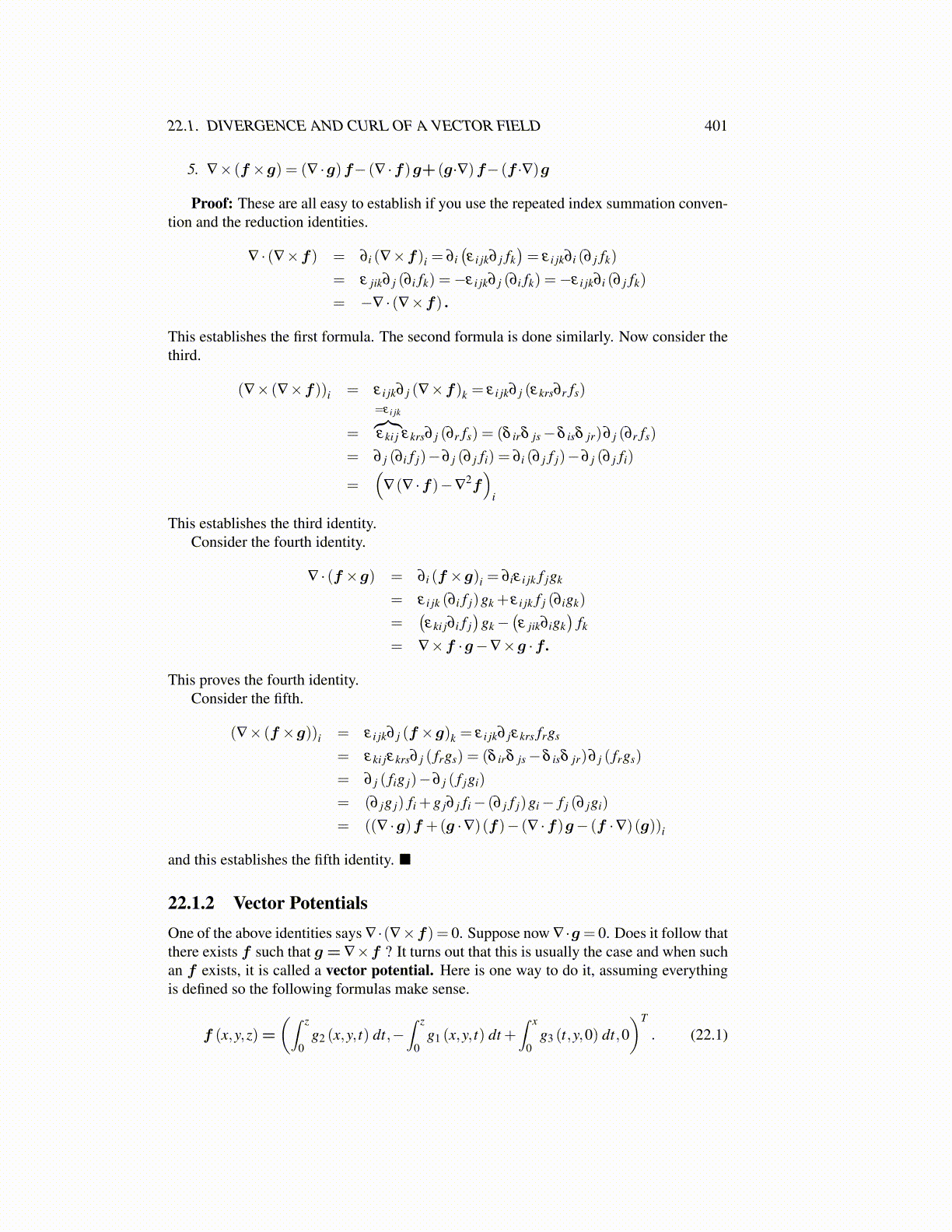
22.1. DIVERGENCE AND CURL OF A VECTOR FIELD 401
5. ∇× (f ×g) = (∇ ·g)f− (∇ ·f)g+ (g·∇)f− (f ·∇)g
Proof: These are all easy to establish if you use the repeated index summation conven-tion and the reduction identities.
∇ · (∇×f) = ∂i (∇×f)i = ∂i(ε i jk∂ j fk
)= ε i jk∂i (∂ j fk)
= ε jik∂ j (∂i fk) =−ε i jk∂ j (∂i fk) =−ε i jk∂i (∂ j fk)
= −∇ · (∇×f) .
This establishes the first formula. The second formula is done similarly. Now consider thethird.
(∇× (∇×f))i = ε i jk∂ j (∇×f)k = ε i jk∂ j (εkrs∂r fs)
=
=ε i jk︷︸︸︷εki j εkrs∂ j (∂r fs) = (δ irδ js−δ isδ jr)∂ j (∂r fs)
= ∂ j (∂i f j)−∂ j (∂ j fi) = ∂i (∂ j f j)−∂ j (∂ j fi)
=(
∇(∇ ·f)−∇2f)
i
This establishes the third identity.Consider the fourth identity.
∇ · (f ×g) = ∂i (f ×g)i = ∂iε i jk f jgk
= ε i jk (∂i f j)gk + ε i jk f j (∂igk)
=(εki j∂i f j
)gk−
(ε jik∂igk
)fk
= ∇×f ·g−∇×g ·f.
This proves the fourth identity.Consider the fifth.
(∇× (f ×g))i = ε i jk∂ j (f ×g)k = ε i jk∂ jεkrs frgs
= εki jεkrs∂ j ( frgs) = (δ irδ js−δ isδ jr)∂ j ( frgs)
= ∂ j ( fig j)−∂ j ( f jgi)
= (∂ jg j) fi +g j∂ j fi− (∂ j f j)gi− f j (∂ jgi)
= ((∇ ·g)f +(g ·∇)(f)− (∇ ·f)g− (f ·∇)(g))i
and this establishes the fifth identity. ■
22.1.2 Vector PotentialsOne of the above identities says ∇ ·(∇×f) = 0. Suppose now ∇ ·g= 0. Does it follow thatthere exists f such that g = ∇×f ? It turns out that this is usually the case and when suchan f exists, it is called a vector potential. Here is one way to do it, assuming everythingis defined so the following formulas make sense.
f (x,y,z)=(∫ z
0g2 (x,y, t) dt,−
∫ z
0g1 (x,y, t) dt +
∫ x
0g3 (t,y,0) dt,0
)T
. (22.1)